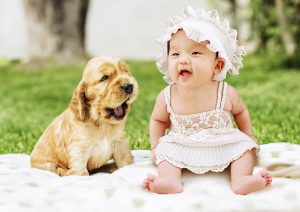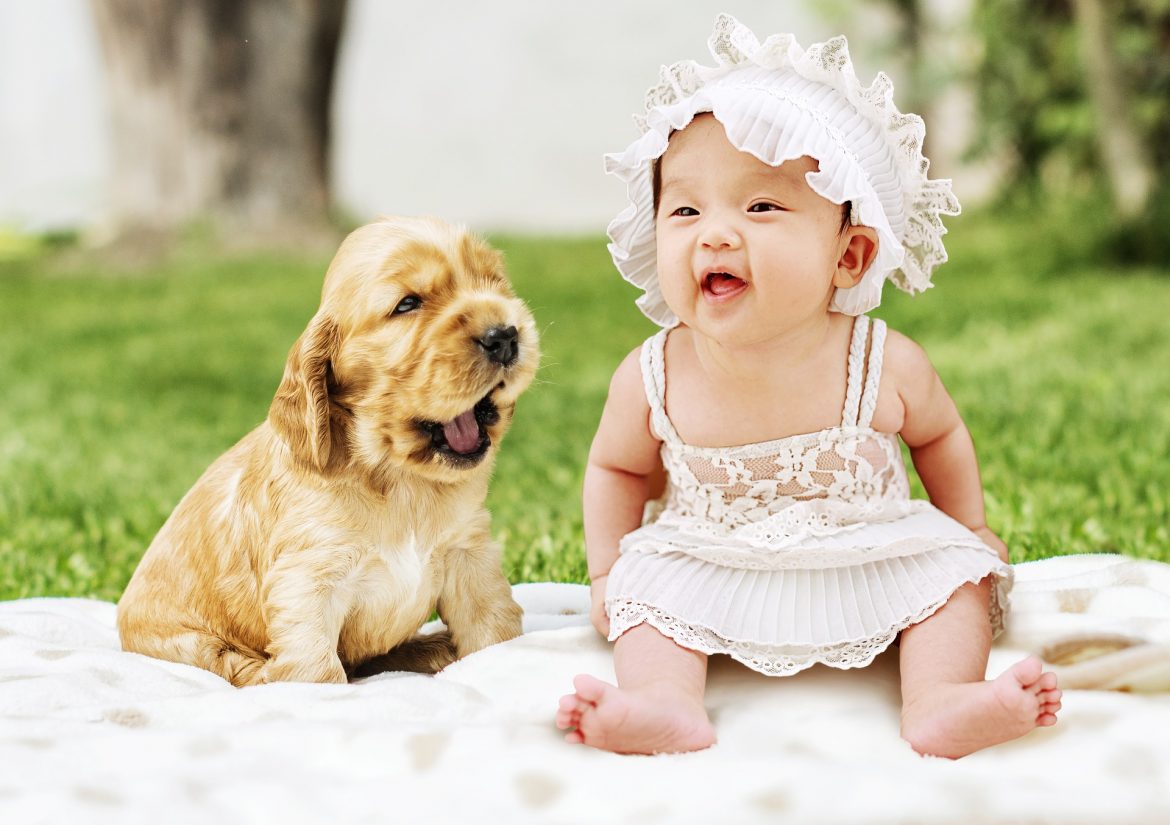Dogs can be such a positive element in a child’s life, as anyone who grew up with a dog will tell you. In the past, we’ve written about the relationship between dogs and children – but dogs and babies are a different league. Dogs can be gentle, loving, and even protective when it comes to babies, keeping them out of harm’s way and giving them plenty of cuddles and kisses. You might have seen adults introducing dogs to babies, or watched videos of huge dogs gently licking a baby’s forehead. It’s an adorable scene.
However, creating harmony in a household with dogs and babies does take planning and patience. Not all pooches react the same way to infants, and it’s important to take precautions when introducing dogs and babies.
In this article, we’re going to outline how you can create a safe space for pups and babies to get to know each other. This is great if you’re going to be welcoming a new baby soon and you already have dogs; you have a friend with a dog who wants to come over and spend time with your baby; or anything in between.
Here are our top five tips for introducing dogs to babies!

Tip #1: If you plan to be introducing dogs to babies, start prepping early
Some dogs can handle a few changes, but others have a hard time adapting. For this reason, you want to start early. In fact, if you’re going to be bringing a baby home in a couple of months, now is the time to start making a few changes around the house.
For one, there’s the issue of who’ll be walking and playing with your pup. If it’s usually the mother-to-be, and she’s going to be busy with the new baby, another member of the household should start taking over the Dog Walking and play times.
A great option for many new parents is to hire a local Dog Sitter or Walker when the baby comes. This is going to be another new person in your pup’s life, so make sure that you introduce them early. Mad Paws has a long list of great Dog Sitters in your area who you can start meeting today.
You’ll also want to start “babyfying” the house as soon as possible. Set up the nursery, install baby barriers to keep your pup out of certain rooms, and start introducing the pram as part of their walks. Another great idea is to introduce the sound of a baby crying into the house before you bring the little one home. When you do this type of familiarisation training, make sure you give plenty of treats and verbal praise when you’re introducing something new. That way, the dog will associate the new baby with good things.
Tip #2: Rely on your dog’s senses
Smell and sight are important tools that your dog uses to gauge whether something is threatening or not. In fact, many of the problems that arise with new parents and dogs stem from a lack of sensory access. When a dog can’t gather the information it needs about a baby, they become anxious. To get a closer look, the dog may jump up. To deal with the unfamiliar smells, they may become defensive.
With this in mind, play to your dog’s senses. Let them sniff an article of the baby’s clothing, and get them used to the smell with treats and cuddles. You can also install transparent doorway barriers, like screens or baby barriers, so that your pup can see you interacting with the baby before you introduce them.
Tip #3: When you’re ready to begin introducing dogs to babies, create a safe space
For the first interaction, it’s important that everyone is relaxed. It’s a good idea to feed exercise your dog before you make the introductions. Following this, walk them into the baby’s room on a lead. Have plenty of treats on hand, and give positive praise as your pup stays calm and sniffs the baby gently.
If your pup just can’t calm down, don’t yell or get stern. Simply walk your pup out and try again when they’re calm. Eventually, they will learn that they can’t go into the baby’s room if they’re excited.
Tip #4: Create a cozy retreat for your pup
As the baby starts to grow – and it’ll happen sooner than you think! – you’ll want to give your dog a safe place to call their own. Crate training is an ideal way to give your dog a private lair for when they need space.
It will also be important to teach your baby not to grab at ears, tails, or fur.
Tip #5: Be patient when introducing dogs to babies
It’s not easy to be a dog and have your life turned upside-down by the presence of a baby. To acknowledge this, give your pup plenty of time to adjust. Try your best to afford your doggo as much love and attention as you can, and don’t get angry when your dog is having a hard time with the changes.
Over time, you can have a loving, harmonious home with pets and babies. It will just take some time, and plenty of treats.

